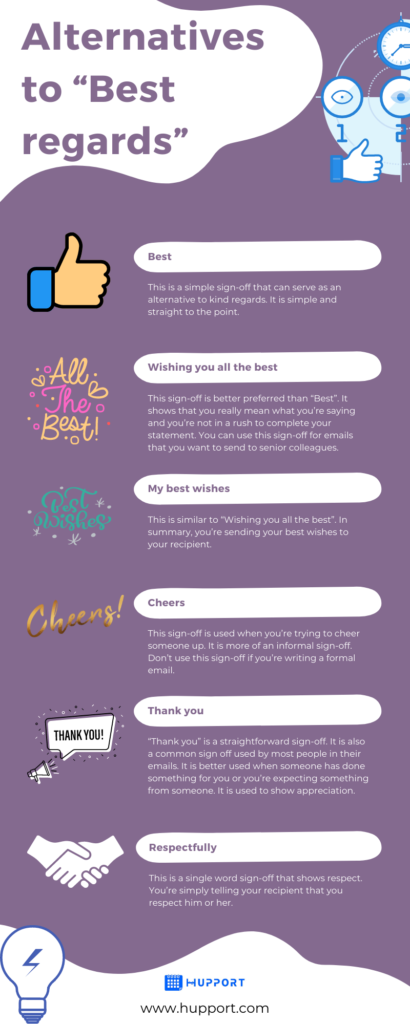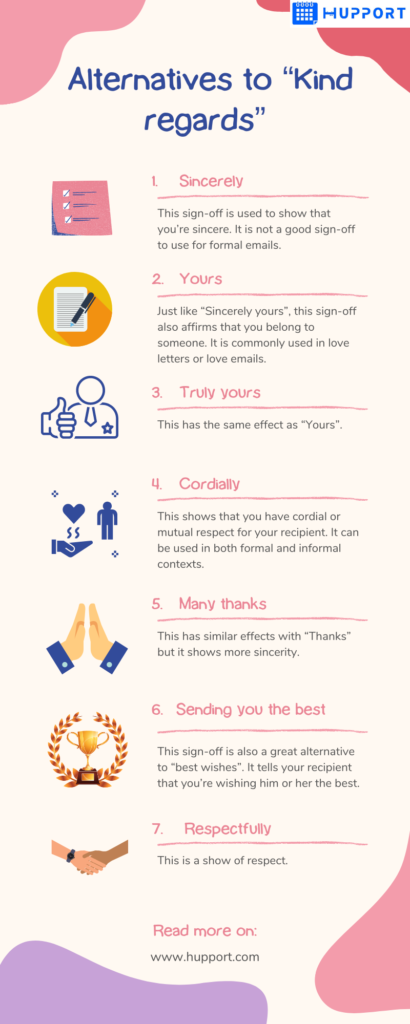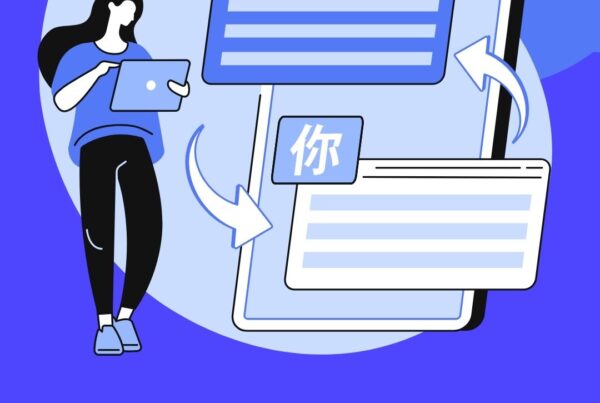For every email you write, a sign-off is very important. The tone of your sign-off will determine how your email recipient will respond to you.
“Kind regards”, “Best wishes”, and “Best regards” are three commonly used sign-offs. Though these are great sign-offs, there are also alternatives that can serve the same purpose as these sign-offs.
Alternatives to “Best regards”

Alternatives to “Best regards”
1. Best
This is a simple sign-off that can serve as an alternative to kind regards. It is simple and straight to the point. You can use this sign off for emails to your friends and junior colleagues but avoid using it if you want to send emails to clients and older colleagues. It is not very detailed and it seems like you’re in a rush.
2. Wishing you all the best
This sign-off is better preferred than “Best”. It shows that you really mean what you’re saying and you’re not in a rush to complete your statement. You can use this sign-off for emails that you want to send to senior colleagues.
3. My best wishes
This is similar to “Wishing you all the best”. In summary, you’re sending your best wishes to your recipient.
4. All the best
This is another great best wishes sign-off. You can also use this sign-off for emails that you want to send to friends and colleagues. HR and employers can use this sign-off in their emails to job seekers.
5. Thank you
“Thank you” is a straightforward sign-off. It is also a common sign off used by most people in their emails. It is better used when someone has done something for you or you’re expecting something from someone. It is used to show appreciation.
6. Thanks again
Just like “Thank you”, “Thanks again” is used to show appreciation. If you have thanked your email recipient before in a previous email for something he or she did, you can use this sign-off in your next email. This sign-off is also good to use if you’re sending an email to a client or customer that purchases your product.
7. Thanks in advance
“Thanks in advance” is used when you’re sending an email while expecting something from your recipient. If you’re sending an email to a prospective client to purchase your product, you can use this sign-off to better encourage or prompt the prospective client into making a purchase. You’re simply thanking the person in advance for what you expect the person to do.
8. Thank you for your time
This sign-off is used after a meeting with a client or anyone. It can also be used in any scenario. You’re simply thanking the person for taking out time to read your email.
9. Respectfully
This is a single word sign-off that shows respect. You’re simply telling your recipient that you respect him or her.
10. Cheers
This sign-off is used when you’re trying to cheer someone up. It is more of an informal sign-off. Don’t use this sign-off if you’re writing a formal email.
11. Talk soon
This sign-off shows that you’re expecting to talk again with your recipient. You can use this sign-off if you’re writing an email to a prospect or lead. It is used with the hope that a conversation or communication channel will stay open.
12. Looking forward to our next conversation
Just like “Talk soon”, this sign-off shows that you want to keep communication with the person. You’re looking forward to keep communicating with the person. It is a common sign-off for salespeople and marketers.
13.Looking forward to hearing from you
Just like “Talk soon”, this sign-off has the same effect. It is used to keep an open communication with someone.
14. Have a wonderful day
You’re simply wishing your recipient a wonderful day. This sign-off can be used in almost any scenario. Ensure that you’re sending the email in the morning and early hours of the day. Also, ensure that your recipient will read your email before evening time or night. If you’re not sure what time is it at the place where your recipient is or you’re not sure your recipient will read your email immediately he or she receives the email, it is better not to use this sign-off.
15. Have a wonderful weekend
Just like “Have a wonderful day”, you’re simply wishing your recipient a wonderful weekend when you use this sign-off. Ensure that you don’t use this sign-off if you’re sending the email from Monday-Thursday. This is because the weekend starts by Friday evening and ends on Sunday. You can only use this sign-off on Friday.
Alternatives to “Kind regards”

16. Sincerely
This sign-off is used to show that you’re sincere. It is not a good sign-off to use for formal emails.
17. Sincerely yours
Only use this sign-off if you’re sending a letter or an email to your lover (wife, husband, boyfriend, or girlfriend). You’re simply affirming to your recipient that you’re his or hers. It is commonly used in love letters.
18. Yours
Just like “Sincerely yours”, this sign-off also affirms that you belong to someone. It is commonly used in love letters or love emails.
19. Truly yours
This has the same effect as “Yours”.
20. Cordially
This shows that you have cordial or mutual respect for your recipient. It can be used in both formal and informal contexts.
21. Thanks
“Thanks” is a show of appreciation. You’re simply thanking your recipient for something he or she has done. Some people don’t take just “Thanks” seriously. They perceive that you may not mean it. “Thank you” is better received by most people.
22. Many thanks
This has similar effects with “Thanks” but it shows more sincerity.
23. Take care
This is commonly used in an informal context. It can be used when sending an email to a friend or family member. You’re simply telling the person to take care of him or herself.
24. Sending you the best
This sign-off is also a great alternative to “best wishes”. It tells your recipient that you’re wishing him or her the best.
25. Respectfully
This is a show of respect.
26. Thank you for reading
You’re simply thanking your recipient for taking our time to read your email. You can use this sign-off if all you want is for your recipient to read your email but if you’re expecting something from your recipient don’t use this sign-off.
27. With gratitude
This is a show of gratitude.
28. With appreciation
This is a show of appreciation for something that your recipient did for you.
29. Love
This is an informal sign-off for people you love or are in a romantic relationship with. It simply shows a sign of affection.
30. Hugs
This also shows a sign of affection. It is an informal sign-off that you can use in emails for your family members or friends
31. XOXO
This is also an informal sign-off. It is a sign of hugs.
32. Lots of love
This is a good sign-off for a personal email to a loved one.
33. Thanks for your consideration
This is an experience of gratitude for something being expected. It can be used in a formal context. Most job seekers use this sign-off but it can call for rejection. Be careful when using this sign-off, especially if you’re expecting something from your recipient.
Alternatives to “Best wishes”
34. All the best
This sign-off is simply used to wish someone the best. It can be used in both formal and informal contexts.
35. I wish you the best
Just like “All the best”, this sign-off can be used to wish someone the best. It is more detailed and clearer.
36. Sending you the best
This has the same effect as “All the best”.
37. Success
This single-word sign-off is used to wish your recipient success in what he or she is about to do. For example, if your friend or colleague is about to write an exam, you can use this sign-off in your email.
38. Success all the way
This sign-off has the same effect as “Success” but more detailed with words.
39. Success in your endeavors
This is used to wish some success in whatever they’re doing.
40. Congratulations
“Congratulations” is used for celebrations. You can send anyone congratulations if they’re celebrating something or have achieved something meaningful.
41. Congratulations in advance
This sign-off is used to congratulate someone for something he or she is expecting.
42. Good luck
You are simply wishing your recipient good luck.
43.I wish you good luck
This sign-off has the same effect as “Good luck”.
44. Have a good one
This is also a good sign-off to wish someone good.
45. Sending good vibes
This is also a good sign-off. It should be used in an informal context.
46. Sending good luck
This same the same effect as “Good luck”.
47. Have a great day
You’re wishing your recipient a good day. An email with this sign-off is best sent in the morning.
48. Have a great weekend
You’re wishing your recipient a good weekend. An email with this sign-off is best sent on Friday.
49. Have a great life
You’re wishing your recipient a great life. This sign-off can be used in different scenarios.
50. Be good
You’re simply telling your recipient to be good and careful.
51. Enjoy your day
You’re telling your recipient to enjoy his or her day. It is commonly used in an informal context.



